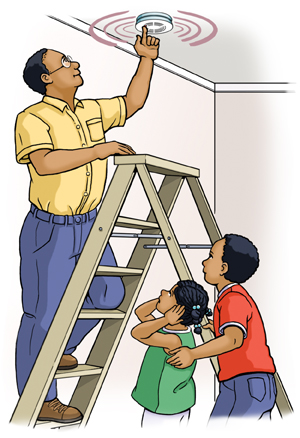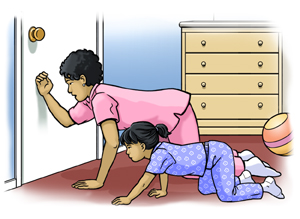Home Fire Safety
Each year, thousands of people, including children, are injured and killed in home fires. Children are often curious about fire, and may not understand the dangers. This makes home fire safety practices especially important. Three important things you can do to keep your home safe from fire are:
-
Install smoke alarms in your home, make sure they work correctly, and test them once a month.
-
Teach children not to play with matches, lighters, and other materials that can be used to start fires. And keep these materials out of children’s reach. Never play with matches or lighters in front of them.
-
Teach children what to do in case of fire. Create a fire safety action plan and practice it.
Here are more details about keeping your family and home safe from fire.
 |
| Test the smoke alarms in your home once a month. Replace the batteries once a year. |
Being prepared for a fire
A home fire can happen at any time. The following can help you be prepared:
-
Install smoke alarms on every level of your home, including the basement and outside all sleeping areas. This simple step cuts your family’s risk of dying in a fire nearly in half:
-
Test smoke alarms monthly, and change the batteries once a year or when the alarm chirps.
-
Don’t disable smoke alarms, even for a short time.
-
Ask your local fire department for tips on where to place smoke alarms in your home.
-
Replace all smoke alarms every 10 years.
-
Think about using voice smoke alarms. These alarms allow you to substitute your own voice for the alarm sound. They're helpful because many children don’t wake up to the sound of a regular smoke alarm.
-
Install carbon monoxide detectors near sleeping areas:
-
Be aware that carbon monoxide is a byproduct of smoke that can be deadly. It’s a gas that you can’t see, smell, or taste.
-
Think about buying a combination smoke alarm and carbon monoxide detector.
-
Check these alarms monthly and replace them as advised on the product insert.
-
Keep fire extinguishers in the home:
-
Keep them in accessible locations, especially in the kitchen.
-
Check usage dates to make sure they're not expired.
-
Use fire extinguishers only when the fire is in a contained area and not spreading. Otherwise, focus on getting out of the home.
-
Train adults to use fire extinguishers. Children should focus on getting out of the home during a fire.
-
If you live in an apartment, talk to your landlord about where smoke alarms are and how often they're tested. Also ask about fire extinguisher locations and emergency exit routes.
Indoor fire safety
Many things in your home are possible fire hazards. Follow these steps to help keep your home safe.
-
Be careful in the kitchen:
-
Never leave food that’s cooking unattended.
-
If a fire breaks out in a cooking pan, put a lid on it to smother it. And never throw water on a grease fire. It will make the fire worse.
-
Conduct a home safety inspection. Look for anything that can cause a fire, such as frayed wires and cords. Fix or remove any fire safety hazards you find.
-
Keep all matches and lighters in a secured drawer or cabinet out of the reach of children. Use childproof lighters.
-
Check to make sure all appliances, including the stove, are turned off before leaving the home.
-
Know where the gas main shut-off is located.
-
Make sure space heaters are stable and have protective covers. Keep them at least 3 feet from anything that can burn, such as curtains. Don’t use space heaters in areas where young kids spend time alone.
-
Keep flammable liquids, such as kerosene and gasoline, locked up and safely stored away from kids and heat.
-
Keep all smoking materials out of reach of children. And never smoke in bed. If possible, smoke outdoors only.
Outdoor fire safety
Fire can be a hazard outdoors as well as indoors. When outdoors, be sure to do the following:
-
Always supervise kids near a barbecue grill, campfire, portable stove, tiki torches, or other outdoor candles.
-
Don’t use fire pits around children. Kids can fall into them, and pits can be hot even after the fire goes out.
-
Keep a garden hose or fire extinguisher handy when cooking outdoors in case of fire.
Teaching your child about fire safety
One of the best ways to keep your home safe from fire is education. Make sure everyone in your family knows fire safety rules, including children.
 |
| Teach your child what to do in case of a fire. For instance, stay low to avoid breathing in smoke. Also, test a door’s temperature with the back of your hand before opening it. |
-
Teach your children the dangers of matches, lighters, and other dangerous items:
-
Teach them to never touch these and other objects that are hot, such as candles.
-
Have them tell you right away whenever they find matches or lighters. Explain that these items are tools for grown-ups, not toys. And never amuse children with matches or lighters.
-
Round up all matches and lighters and store them safely. In case you missed some, ask your children to tell you where any are located throughout your home.
-
Never leave a child alone in a room with a lit candle. Don’t let teens have candles in their rooms.
-
Show children what to do in case of fire:
-
Be sure your kids know what the fire alarm sounds like and what to do if it goes off.
-
Teach kids what to do if their clothes catch fire: Stop, Drop to the ground, and Roll until the fire is put out. They should also cover their face with their hands. Practice these steps with your children. Make sure they understand that running will make the fire burn faster.
-
Show children how to crawl below smoke during a fire.
-
Make sure kids know at least 2 escape routes from each room in the home. These escape routes can be windows.
-
Teach kids to test doors for nearby fire by feeling for heat with the back of their hand. If the door is warm or hot, they should try their second exit.
-
Explain to children that they can’t hide from a fire. Hiding in a closet or under a bed won’t make them safe. Instead, they should try to escape the home. And if they can’t escape, they should let others know they're trapped. They can do this by shutting the door to the room, opening a window, and turning on the lights.
-
Talk to your local fire department:
-
Introduce your children to a firefighter. Let them know that firefighters will look different when in full protective gear. Tell them to never hide from firefighters, and to follow all directions from firefighters during a fire.
-
Find out if the fire department has a fire safety program for kids.
Create a fire safety plan
Create a plan for your family to follow in case of a fire. Try making it a family project. Important steps for the plan include leaving the home right away and having a designated meeting place:
-
Make sure your child understands to “get out and stay out.” They should get out of the home immediately and not go back in, even if family members or pets are still inside.
-
Decide on a safe meeting place away from the home for everyone to gather.
-
Teach children to call 911 or emergency services from a cell phone or neighbor’s phone. Make sure they know to do this only after they are safely out of the home.
-
Teach your children the fire safety plan. Practice it and make sure they understand it.
-
Have fire drills twice a year to keep your children prepared in case of fire.
-
Visit the National Fire Protection Association website at www.nfpa.org for more information.
Online Medical Reviewer:
Amy Finke RN BSN
Online Medical Reviewer:
Dan Brennan MD
Online Medical Reviewer:
Rita Sather RN
Date Last Reviewed:
10/1/2024
© 2000-2025 The StayWell Company, LLC. All rights reserved. This information is not intended as a substitute for professional medical care. Always follow your healthcare professional's instructions.